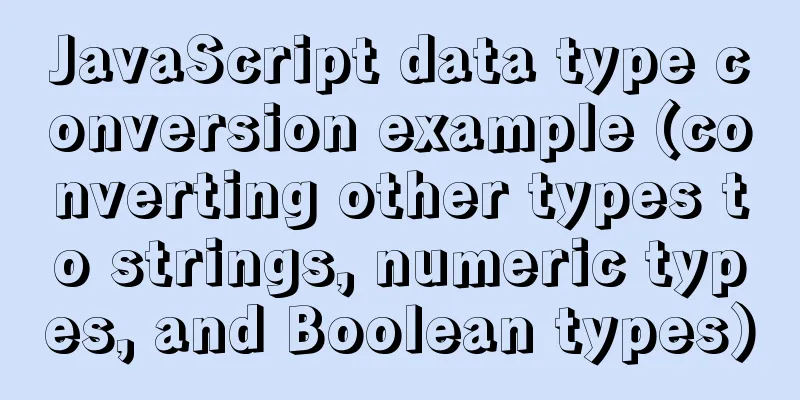Detailed explanation of uniapp's global variable implementation

Preface This article summarizes some implementation methods of uniapp global variables. The detailed knowledge comes from the implementation of global variables in uniapp on the uView official website. Interested students can go to the uView official website and search for vuex to view it. How to implement global variablesGenerally speaking, there are several ways in uniapp:
The following is an introduction to the implementation of these five methods. Local Storage Permanent storage, for example, even if the app is closed, the data will still be stored This is a permanent storage method, similar to the web's Local Storage (about Cookies, Tokens, SessionStorage, LocalStorage, will be organized in another article). This method is used when we need to permanently store a user's information, but it should be noted that this method needs to avoid frequent acquisition and modification of stored data, because it will have a certain impact on performance. Variables within the application declaration cycle should not use this method There are two types of storage: synchronous and asynchronous Synchronous storage
//Synchronous storage uni.setStorageSync("key","value")
//Synchronous acquisition let value = uni.getStorageSync("key")
console.log("I will wait until the above is completed before executing)
Asynchronous Storage
uni.setStorage({
key:"key",
data:"value",
success:function(){
//Storage successful callback console.log("I am the callback of asynchronous storage, I will be executed after val is declared")
}
})
let val = 1 //This line will first execute uni.getStorage({
key:"key",
success:function(res){
//Store successful callback console.log("I am the callback obtained asynchronously, I will be executed after val2 is declared")
}
})
let val2 = 2 // This line will be executed first Configuration Files This is a method of using modular file export. First write the variable in the js file, and then export it in the form of export default. Generally speaking, the global variables implemented in this way are variables that must be used before the application is installed by the user and when the user uninstalls it, such as the domain name requested to the backend. This method is not suitable for other situations. At the same time, this method also has disadvantages, that is, each use requires the introduction of files config.js
//For example, in config.js we exported a base domain name export default {
baseUrl:"http://www.test.com"
} index.js
//Introduce this file through import import config from "../common/config.js"
export default {
onLoad(){
console.log(config.baseUrl)//baseUrl:"http://www.test.com"
}
} Mount to Vue.prototype This is a way to implement it using prototypes (about js prototype chain and inheritance, will be sorted out in another article), but this method will have special performance on WeChat applet Note: In WeChat applet, templates cannot directly read and display the global variables introduced. //The config.js here refers to the file already written above import config from "./common/config.js" //Mount baseUrl to Vue, and then you can access it in pages and components through this.baseUrl Vue.prototype.baseUrl = config.baseUrl Page
<template>
<!-- The value is undefined in WeChat applet, valid on other terminals-->
<view>
The value is: {{this.baseUrl}}
</view>
</template>
<script>
export default {
onLoad() {
console.log(this.baseUrl)//"http://www.test.com"
}
}
</script>
globalData This method is unique to WeChat Mini Programs. Mini Programs cannot use vuex, so globalData appears. Uniapp is another implementation of Mini Programs, so globalData also appears. There are a few things to note when using globalData:
Explain the second point, why do we need to get the value in onShow? Is onLoad not possible? Because if both A and B pages introduce globalData, and B modifies the value of globalData inside the page and returns to A page, then A page is not destroyed and the onLoad life hook will not be called. Only onShow will be executed. If you try to get globalData in onLoad, it will not be executed, and responsiveness cannot be achieved. App.vue
export default{
//Need to define globalData in App.vue
globalData:{
userName:"Bai Juyi"
},
//Note here that if you want to use globalData in App.vue, you cannot use getApp().globalData.Name directly, because getApp() has not been generated at this time // 1. Non-V3 mode, you can get it through this.$scope.globalData // 2. V3 mode, you can get it through getApp({allowDefault: true}).globalData onLaunch(){
console.log(this.$scope.globalData.userName)
}
}
After defining globalData in App.vue, we can use it in the page
<template>
<view>
<view>
<!-- Note that getApp().globalData.userName cannot be used directly in the template -->
The author of <<The Charcoal Seller>> is: {{author}}
</view>
<view>
<u-button @click="modifyUserName">Modify userName value</u-button>
</view>
</view>
</template>
<script>
export default {
data() {
return {
author: ''
}
},
onShow() {
// Every time A.vue appears on the screen, onShow is triggered, thus updating the author value this.author = getApp().globalData.userName;
},
methods: {
modifyUserName() {
//The value of globalData is modified at this time getApp().globalData.userName = "诗圣";
// After modifying userName, the author of this page will still not be automatically refreshed, because globalData is not responsive. // We still need to manually refresh the author value of this page, which shows the disadvantages of globalData this.author = getApp().globalData.userName;
}
}
}
</script>
How to implement Vuex It is strongly recommended to use vuex. There are two ways to use vuex in uniapp, one is based on the traditional vue method, and the other is the uView encapsulation method. The following introduces the encapsulation of vuexd on the uView official website Traditional implementation Here is only a brief introduction to the traditional use of vuex. If you don’t know vuex, you can go to the vue official website to view the official documentation Create a store file in the root directory of uni.app and create an index.js file in it with the following content
//index.js
import Vue from "vue"
import Vuex from "vuex"
Vue.use(Vuex)
const store = new Vuex.Store({
state:{
vuex_token:"123456"
},
//Methods for synchronously modifying the value in state mutations:{
//Payload is a parameter passed in when the user uses mutations. It can be a single value or an object modifyToken(state,payload){
state.vuex_token = payload.token
}
}
})
export default store
Import in main.js
import store from '@/store';
//Put the store into the Vue object creation const app = new Vue({
store,
...App
})
Use in page
<template>
<view>
<view>
Token value is {{vuex_token}}
</view>
<u-button @click="btnClick">Modify vuex_token</u-button>
</view>
</template>
<script>
//This is the API provided by Vue to make it easier to use the store. For details, please go to Vue official documentation import {mapState, mapMutations} from 'vuex';
export default {
computed: {
...mapState(['vuex_token'])
},
methods: {
...mapMutations(['modifyToken']),
btnClick() {
// The second parameter here can be a normal variable or object, customized, and processed according to mutation requirements (without using mapMutations)
this.$store.commit('modifyToken', {token: 'xxxyyyzzz'}
//Using mapMutations this.modifyToken({token: 'xxxyyyzzz'})
}
}
}
</script>
uView's vuex implementation (key points)First of all, let's talk about why uView encapsulates vuex. There are two reasons for this:
In response to these problems, uView officially provides a set of methods for encapsulating and using vuex. This method combines LocalStorage and vuex, so that users no longer have to make tedious calls to vuex and consider the problem of refresh loss. Below I will show the code and explain its ideas and process.
Idea: The general idea of index.js is as follows a. In order to solve the problem that vuex refreshes and loses data and cannot store it permanently, a lifeData object is created. This object will be stored in LocalStorage through a function to achieve the effect of permanent preservation. At this time, I only need to store the data that needs to be permanently saved in vuex in this object in the form of key and value. b. In order to solve the problem that each time vuex is used, the function in mutations needs to be used to operate the variables in the corresponding store, and the $uStore method is encapsulated to operate all variables in the store. Of course, only a simple copy operation is performed. For more extended functions, users can encapsulate functions in mutations for expansion. c. Encapsulate a saveStateKeys array. The data in this array will be retrieved when the app starts, so we can put some data that needs to be obtained when the app starts, such as the information of the last time the user logged in in the application. In fact, saveStateKeys and lifeData are used together. Only variables in saveStateKeys will be stored in lifeData during storage to achieve permanent storage. The rest is the same as the ordinary vuex storage method. We can see this in the following code
//Introduce Vuex, vue Use Vuex, this step is no different from the general use of vuex import Vue from 'vue'
import Vuex from 'vuex'
Vue.use(Vuex)
//Create a variable to store data that needs to be stored permanently let lifeData = {};
try{
// Try to get whether the lifeData variable exists locally. It does not exist when the APP is started for the first time. lifeData = uni.getStorageSync('lifeData');
}catch(e){
}
// Need to be stored permanently and retrieved the next time the APP is started, the variable name in the state let saveStateKeys = ['vuex_user', 'vuex_token'];
// Save variables to local storage (no loss when refreshing/restarting (app does not refresh, app will only restart))
const saveLifeData = function(key, value){
// Determine whether the variable name is in the array to be stored // This is to determine if the variable name is stored in saveStateKeys, then store it in lifeData for permanent storage, otherwise it is the same as the general vuex storage method if (saveStateKeys.indexOf(key) != -1) {
// Get the locally stored lifeData object and add the variable to the object let tmp = uni.getStorageSync('lifeData');
// The first time you open the app, there is no lifeData variable, so put an {} empty object tmp = tmp ? tmp : {};
tmp[key] = value;
// After executing this step, all variables that need to be stored are mounted in the local lifeData object uni.setStorageSync('lifeData', tmp);
}
}
const store = new Vuex.Store({
// The following values are just examples, please delete them during use state: {
// If there is a corresponding attribute under the lifeData object obtained from the local above, assign it to the corresponding variable in state // Adding the vuex_ prefix prevents variable name conflicts and makes it clear at a glance // The permanently stored data will be obtained from lifeData because lifeData is already stored locally vuex_user: lifeData.vuex_user ? lifeData.vuex_user : {name: '明月'},
vuex_token: lifeData.vuex_token ? lifeData.vuex_token : '',
// If vuex_version does not need to be saved to local permanent storage, lifeData.vuex_version method is not required vuex_version: '1.0.1',
},
mutations:
$uStore(state, payload) {
//Payload is the object passed in when this.$u.vuex is called later //such as this.$u.vuex("user.info.score","jack") payload = {name:"user.info.score",value:"jack"}
// Determine whether it is a multi-level call, and the object exists in the state, such as user.info.score = 1
let nameArr = payload.name.split('.');//[user,info,score]
let saveKey = '';
let len = nameArr.length;
if(nameArr.length >= 2) {
let obj = state[nameArr[0]];
for(let i = 1; i < len - 1; i ++) {
obj = obj[nameArr[i]]; // At this time, obj is user.info, of course, it is still an empty data}
//nameArr[len-1] is score, obj[nameArr[len - 1]] is equivalent to user.info.score
obj[nameArr[len - 1]] = payload.value;
saveKey = nameArr[0];
} else {
// Single-level variable, in the case where state is a normal variable state[payload.name] = payload.value;
saveKey = payload.name;
}
// Save variables locally, see the top function definition saveLifeData(saveKey, state[saveKey])
}
}
})
export default store
Create a mixin.js file in the same directory Ideas: ps: minxi (mixin) is an API provided by Vue to implement global functions. There are many ways to mix in. Here, global mixin is used. If you don’t know much about mixin, you can go to the Vue official website to view relevant documents
//mixin.js
import { mapState } from 'vuex'
import store from "@/store"
// Try to load all the state variables of the user's vuex in store/index.js in the root directory into global variables let $uStoreKey = [];
try{
$uStoreKey = store.state ? Object.keys(store.state) : [];
}catch(e){
}
module.exports = {
created() {
//Hook the vuex method to this.$u //Usage method: If you want to modify the user.name variable in the vuex state to "epic" => this.$u.vuex('user.name', 'epic')
// If you want to modify the version variable of vuex's state to 1.0.1 => this.$u.vuex('version', '1.0.1')
this.$u.vuex = (name, value) => {
this.$store.commit('$uStore', {
name,value //Do you recall the payload passed in by $uStore? haha
})
}
},
computed: {
// Deconstruct all variables in vuex's state into the global mixin...mapState($uStoreKey)
}
}
Start global mixing and introduce the mixin.js file into main.js for mixing
//main.js
let vuexStore = require("@/store/$u.mixin.js");
Vue.mixin(vuexStore);Put the store in the Vue instance
//main.js
import store from '@/store';
//Put the store into the Vue object creation const app = new Vue({
store,
...App
})
The above is the official encapsulation of vuex by uView. It is very convenient to use this encapsulated vuex in app development. At the same time, you can also expand your own methods in @/stote/index.js as needed. ConclusionThe above are different ways to implement uniapp global variables. Which one to use needs to be selected according to the actual situation in actual development. I personally feel that uView's encapsulation of vuex has a very high reference value for me who is new to the front end, so I specially sorted it out for sharing. This is the end of this article on the detailed explanation of uniapp's global variable implementation method. For more relevant uniapp global variable content, please search for previous articles on 123WORDPRESS.COM or continue to browse the following related articles. I hope everyone will support 123WORDPRESS.COM in the future! You may also be interested in:
|
<<: How to use the WeChat Mini Program lottery component
>>: Example code for implementing anti-shake in Vue
Recommend
List rendering instructions for efficient development of Vue front-end
v-for directive Speaking of lists, we have to men...
MySQL 5.7.23 version installation tutorial and configuration method
It took me three hours to install MySQL myself. E...
A Brief Analysis of CSS Selector Grouping
Selector Grouping Suppose you want both the h2 el...
How to restore docker container data
The project test environment database data is los...
Analysis of the difference between Mysql InnoDB and MyISAM
MySQL supports many types of tables (i.e. storage...
Share some key interview questions about MySQL index
Preface An index is a data structure that sorts o...
Detailed explanation of the construction and use of Docker private warehouse
The image can be saved on hub.docker.com, but the...
Example of how to mosaic an image using js
This article mainly introduces an example of how ...
MySQL group by method for single word grouping sequence and multi-field grouping
I have created a goods table here. Let's take...
MySQL foreign key (FOREIGN KEY) usage case detailed explanation
Introduction: The disadvantages of storing all da...
How to authorize all the contents of a folder to a certain user in Linux?
【Problem Analysis】 We can use the chown command. ...
Perfect solution to the problem of MySQL shutting down immediately after startup (caused by ibdata1 file corruption)
The mysql on a server in the computer room had be...
Don't forget to close the HTML tag
Building web pages that comply with Web standards ...
Implementing access control and connection restriction based on Nginx
Preface Nginx 's built-in module supports lim...
How to completely delete the MySQL service (clean the registry)
Preface When installing the executable file of a ...









